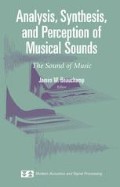Abstract
An ideal music-synthesis technique provides both high-level spectral control and efficient computation. Simple playback of recorded samples lacks spectral control, while additive sine-wave synthesis is inefficient. Wavetable and frequencymodulation synthesis, however, are two popular synthesis techniques that are very efficient and use only a few control parameters.
Access this chapter
Tax calculation will be finalised at checkout
Purchases are for personal use only
Preview
Unable to display preview. Download preview PDF.
References
Allen, J. B. (1977). “Short term spectral analysis, synthesis, and modification by discrete Fourier transform,” IEEE Trans. on Acoustics, Speech, and Signal Processing ASSP-25(3), 235–238.
Beauchamp, J. (1993). “Unix workstation software for analysis, graphics, modification, and synthesis of musical sounds,” 94th Convention of the AES, Berlin, Audio Eng. Soc. Preprint 3479.
Beauchamp, J. and Horner, A. (1998). “Spectral modelling and timbre hybridisation programs for computer music,” Organised Sound 2(3), 253–258.
Berger, K. W. (1964). “Some factors in the recognition of timbre,” J. Acoust. Soc. Am. 36(10), 1888–1891.
Chowning, J. M. (1973). “The synthesis of complex audio spectra by means of frequency modulation,” J. Audio Eng. Soc. 21(7), 526–534.
Chowning, J. (1980). “Computer synthesis of the singing voice,” Sound Generation in Wind, Strings, Computers. Papers by Benade, Chowning, Hutchins, Jansson, Alonso, Moral given at Seminars of The Committee for the Acoustics of Music. Royal Swedish Academy of Music No. 29, pp. 4–13.
Clark, M., Luce, D., Abrams, R., Schlossberg, H., and Rome, J. (1963). “Preliminary experiments on the aural significance of parts of tones of orchestral instruments and on choral tones,” J. Audio Eng. Soc. 11(1), 45–54.
Dolson, M. (1986). “The phase vocoder: A tutorial,” Computer Music J. 10(4), 14–27.
Goldberg, D. E. (1989). Genetic Algorithms in Search, Optimization, and Machine Learning (Addison-Wesley, Reading, MI).
Grey, J. and Moorer, J. (1977). “Perceptual evaluations of synthesized musical instrument tones,” J. Acoust. Soc. Am. 62(2), 454–462.
Holland, J. H. (1975). Adaptation in Natural and Artificial Systems (University of Michigan Press, Ann Arbor, MI).
Horner, A., Beauchamp, J., and Haken, L. (1993a). “Machine tongues XVI: Genetic algorithms and their application to FM matching synthesis,” Computer Music J. 17(4), 17–29.
Horner, A., Beauchamp, J., and Haken, L. (1993b). “Methods for multiple wavetable synthesis of musical instrument tones,” J. Audio Eng. Soc. 41(5), 336–356.
Horner, A. (1996a). “Double modulator FM matching of instrument tones,” Computer Music J. 20(2), 57–71.
Horner, A. (1996b). “Computation and memory tradeoffs with multiple wavetable interpolation,” J. Audio Eng. S. 44(6), 481–496.
Horner, A. and Beauchamp, J. W. (1996). “Piecewise linear approximation of additive synthesis envelopes: A comparison of various methods,” Computer Music J. 20(2), 72–95.
Horner, A. (1998). “Nested modulator and feedback FM matching of instrument tones,” IEEE Transactions on Speech and Audio Processing 6(4), 398–409.
Justice, J. H. (1979). “Analytic signal processing in music computation,” IEEE Transactions on Acoustics, Speech, and Signal Processing ASSP-27(6), 670–684.
Le Brun, M. (1977). “A derivation of the spectrum of FM with a complex modulating wave,” Computer Music J. 1(4), 51–52.
Maher, R. C. and Beauchamp, J. W. (1990). “An investigation of vocal vibrato for synthesis,” Applied Acoustics 30(2&3), 219–245.
McAulay, R. and Quatieri, T. (1986). “Speech analysis/synthesis based on a sinusoidal representation,” IEEE Trans. on Acoustics, Speech, and Signal Processing 34(4), 744–754.
Payne, R. G. (1987). “A microcomputer based analysis/resynthesis scheme for processing sampled sounds using FM,” in Proc. 1987 Int. Computer Music Conf., Urbana, IL (Int. Computer Music Assoc., San Francisco), pp. 282–289.
Press, W., Flannery, B., Teukolsky, S., and Vetterling, W. (1985). Numerical Recipes: The Art of Scientific Computing (Cambridge University Press, Cambridge, UK).
Schottstaedt, B. (1977). “The simulation of natural instrument tones using frequency modulation with a complex modulating wave,” Computer Music J. 1(4), 46–50.
Serra, M.-H., Rubine, D., and Dannenberg, R. (1990). “Analysis and synthesis of tones by spectral interpolation,” J. Audio Eng. Soc. 38(3), 111–128.
Sundberg, S. (1974). “Articulatory interpretation of the singing formant,” J. Acoust. Soc. Am. 55(4), 838–844.
Tan, B. T. G. and Lim, S. M. (1996). “Automated parameter optimization for double frequency modulation synthesis using the genetic annealing algorithm,” J. Audio Eng. Soc. 44(1/2), 3–15.
Editor information
Editors and Affiliations
Rights and permissions
Copyright information
© 2007 Springer
About this chapter
Cite this chapter
HORNER, A. (2007). A Comparison of Wavetable and FM Data Reduction Methods for Resynthesis of Musical Sounds. In: Beauchamp, J.W. (eds) Analysis, Synthesis, and Perception of Musical Sounds. Modern Acoustics and Signal Processing. Springer, New York, NY. https://doi.org/10.1007/978-0-387-32576-7_6
Download citation
DOI: https://doi.org/10.1007/978-0-387-32576-7_6
Publisher Name: Springer, New York, NY
Print ISBN: 978-0-387-32496-8
Online ISBN: 978-0-387-32576-7
eBook Packages: Physics and AstronomyPhysics and Astronomy (R0)

